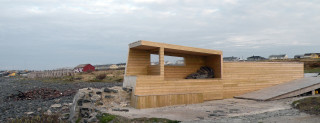Who is the better architect?

Architecture is instrumentally applied in place development strategies. But how does this play out in Vardø in Northern Norway?
The celebrated architect Peter Zumtor designed and built the Steilneset Memorial to the Victims of Witch Trials in Vardø (in collaboraton with Louise Bourgeois). The monument is part of the National Tourist Routes project by the Norwegian Public Roads Administration, which celebrates roadbuilding and supports and promotes road based tourism. Situated at the furthest point of the tourist route, on the city island that faces the Barents Sea, the monument marks, in a spectacular way, the end of the journey—with the hope of drawing tourists all the way to the end of a long country.
The stories of witch burning is fascinating and thought-provoking, and the monument highlights the history of the part of the country furthest away from the populations centers in the South. Architecturally, the structure is excellently executed and its external structure is reminiscent of the fish drying racks found all along the coast of Northern Norway, thus linking it to its costal location in an old fishing community.
On the Vardø Island it is possible to spot the work of another architectural practice—the local office Biotope comprising the partners Tormod Amundsen and Elin Taranger. Their work is also distinct: low wooden structures, often with a slanted profile, located in the landscape to house and give shelter to the bird watchers that are attracted to the spectacular bird fauna of the Islands.
Just as Zumtor’s monument is part of a larger program of tourism infrastructure, the bird-watching shelters of Biotope also form part of a larger ‘infrastructure’ that aims to establish Vardø and the Varanger Peninsula as one of the primary bird-watching destinations in the World. As such their work include not only the designed and built structures, but also the mapping of the landscape and natural resources, media presence, branding, agreements and collaborations with partner businesses and tourism agencies, leaflets, posters and even images of bird watchers stenciled on the weather beaten facades of the town.
The works of both these practices are contextual and relate to site and context. Zumptor’s monument by revealing history and referencing vernacular constructions, Biotope by carefully mapping landscape and bird behavior and by activating local businesses and entrepreneurs. The National Tourist Road project is by many considered a successful as it transforms infrastructure to experiences, and attracts visitors to peripheral locations, generating income to local communities. The hope is that this will happen in Vardø too. Place branding through architecture, employing ‘star-chitects’ to design spectacular cultural buildings to attract visitors, has been a worldwide trend since Frank Gehry designed the Guggenheim Museum that helped elevate the former industrial town of Bilbao in Northern Spain to cultural prominence, multiplying visitor numbers.
Architectural practices of resource and landscape mapping has not yet received the same kind of attention as a strategy of geographical branding and place development, but in the case of Vardø it is possible to argue that this low-cost approach has produced a highly particular, composite kind of architecture that really succeeds in drawing visitors and (re)generate local economy, in a way that is recognized by, and contributes to build, local community. It raises awareness of place specificity in both locals and visitors, to a degree that the formally exquisite (and rather expensive) work by the internationally renowned architect/artist team has not achieved.



